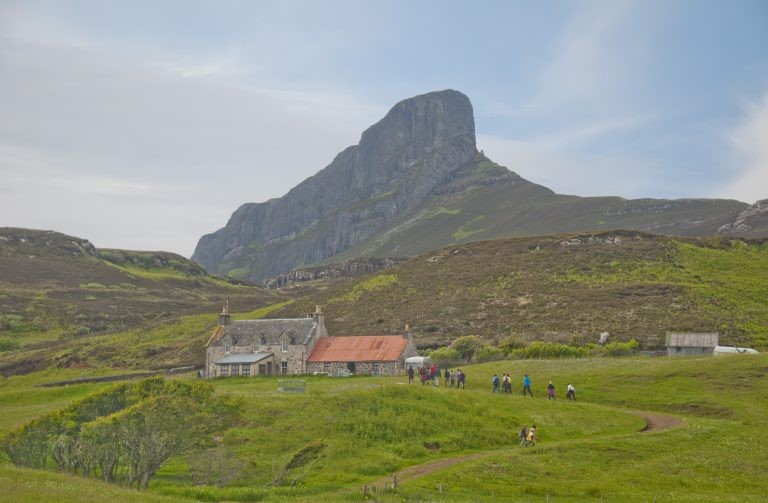
Island facts

The Isle of Eigg is one of the Inner Hebridean Islands. About five miles long by three miles wide, Eigg lies 10 miles off the Scottish Mainland West coast, South of the Isle of Skye. The island has a fascinating history, superb wildlife and a vibrant community. Eigg is owned by the Isle of Eigg Heritage Trust who have managed it on behalf of the community since the community buyout of 1997. The Trust has responsibility for stewardship of the island, its buildings and natural heritage, and for supporting future development.
All this is part of what makes Eigg attractive but what makes it unique is the strong community and feeling of empowerment by the residents to take responsibility for their lives and future.
What is Eigg's current situation regarding the energy transition?
Eigg community consists of just above 100 permanent residents living in 53 houses. We have a community hall for big events, meetings and sports activities; and a social hub that includes a grocery shop, a restaurant/bar and a craft shop. 11,500 people visit Eigg each year.
Eigg is not connected to the mainland electricity supply. After decades of diesel generators, Eigg Electric provided 24 hour power for the first time in February 2008. Eigg Electric is a community-owned, managed and maintained company that provides electricity for all island residents from renewable sources of water, sun, and wind.
The system consists of three hydroelectric generators, a group of four small wind generators and an array of solar electric panels. The hydroelectric capacity is approximately 110kW, the maximum output of the wind farm is 24kW and the solar electric panels can produce up to 50kW. The total generating capacity of the whole system is approximately 184kW.
To ensure nobody goes short, each house has a maximum use limit at any one time of 5kW; most businesses 10kW. And to cover occasions when renewable generation is low, the system is supported by a pair of 80kW diesel generators, which act as backup and are switched into the system automatically as needed.
At present, the system does not have the capacity to generate enough electricity to power electric cookers, showers or heating systems and most people use bottled gas for cooking. Heating is by a range of fuels. Kerosene central heating is popular, usually with a wood-burning stove for backup. A few households still burn coal but the commonest form of domestic heating is by wood. 26 households burn only wood and of these 20 use the most sustainable source as it is grown and processed locally on Eigg. The other seven use pellets or briquettes which are brought onto the island. Twelve households and the Pier Centre all have solar water heaters.

In monetary terms, the cost of energy per average household is:
- Electricity: average of ₤40 per month
- Local wood is processed on the island and 1m³ can be purchased for ₤80. This would last for approx. 3 weeks if it is the only source of fuel.
- Coal costs 10kg £5.50, 25kg £12.90 from the shop or £350 for a metric ton.
- Bottled gas costs roughly £80 for a 49kg cylinder.
- A cubic meter of kerosene can be purchased for £520, which might cover the needs of a medium household for a year.
Renovating Eigg's buildings
Whenever possible, the tendency has been to maintain old stone houses and renovate them but some still have insulation issues. Since the Isle of Eigg buyout in 1997, 14 new houses with improved insulation have been built and more efficient wood and pellet burners and boilers had been installed. However, some older properties still have inefficient multi-fuel stoves and struggle to maintain heat. These householders are more likely to supplement wood with coal.
Improving transport on the Isle of Eigg
We could say the island has two main population nuclei, each one on one side of the 4-mile road that crosses Eigg from south to north. The main way of travelling from one side to another of the island is by private car, mainly diesel, although 6 electric cars and 2 hybrids are part of the fleet too. During the high season two minibuses transport visitors from one side to the other, one as a regular bus and the other as a taxi. A few people cycle and there are 3 electric bikes on Eigg.
In/out island access is through MV LochNevis, a boat ferry service that runs six days a week from the end of March to September and four days a week during the winter. A passenger-only boat sails from Arisaig to Eigg five days a week from April to September.
Why Eigg decided to embark on the energy transition
The transition started on Eigg when a small number of residents installed renewable systems which allowed a small amount of 24hour electricity instead of the few hours most people used their generators for.
The island electricity grid was switched on in 2008 which has allowed major changes to life and businesses to develop.

The same year Eigg began a year-long series of projects as part of their success as one of ten finalists in NESTA's Big Green Challenge. Improving resilience and energy efficiency to reduce our carbon footprint by 48%. A number of initiatives were carried out including the installation of solar water panels, encouraging the use of alternative fuels and supporting domestic insulation improvements.
In January 2010, Eigg was announced as one of three joint winners in NESTA's Big Green Challenge, winning a prize of £300,000. Eigg also won the prestigious UK Gold Award in July 2010. This capital allowed us to improve the capacity of the grid and further develop the wood fuel business.
This project brought the community together but there is now a general awareness that our energy use still needs to be improved, especially within the context of climate change.
An enthusiastic local population solving the energy transition one challenge at a time
Over the past few years an increasing number of people on Eigg have become more interested and motivated to help with environmental issues but there are major challenges making this difficult. Residents are busy so there is a lack of time to work on extra activities. This is especially evident during the Summer months when the majority of residents work in some capacity with visiting tourists. There are many issues to be tackled, resulting in a feeling for many people of being overwhelmed. At the same time, many people feel they need more information on the best ways to help and make necessary changes.
There are also financial and practical challenges to making change. For example, installing a more efficient system to heat your home or water can be very expensive, especially if it involves a lot of retrofitting of pipes, insulation etc. In terms of infrastructure, the current electrical grid requires maintenance and expanding but financial resources are limited.

Other present issues for Eigg include waste management, protection of the seas around us and transport - the ferry, old diesel cars and limited train service from the ferry port.
Organisations currently involved in Eigg's energy transition:
Isle of Eigg Heritage Trust
Eigg Electric
Eigg Trading Ltd
Isle of Eigg Residents Association
Small Isles Community Council
Highland Council

